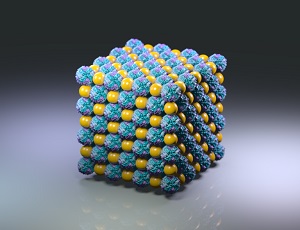
A team of scientists from the Jagiellonian University and Aalto University in Helsinki have succeeded in placing enzymes into protective protein cages which were then assembled into crystals. The enzymes still function, but are shielded from harsh environmental conditions by the cages. The pioneering research was conducted at the JU Małopolska Centre of Biotechnology.
Enzymes are very useful proteins. These tiny nanomachines carry out vital roles in our cells but are also used in industry and commercially (e.g. in stain-digesting enzymes in biological washing powders). Often though, proteins can be rather fragile things and some enzymes, when taken outside of their cellular environments, break down and are no longer functional. The researchers solved this problem using a 'Russian Doll' approach. They took a common protein called ferritin which has the shape of a hollow sphere and is exceptionally stable, and found a way to take it apart and put it back together again, allowing them to put an enzyme inside. The test enzyme (lysozyme), once inside the cage, was still able to work and continued to do so at high temperatures which would normally inhibit it.

'This could be because the walls of the ferritin actually stop the protein from losing its shape when heated, but we’d need to do more work to see if this is really the case', commented Jonathan Heddle, the senior author of the research. In the next stage of the research, the scientists were able to mix the filled ferritins with specially modified gold particles so that they would stick together, resulting in larger crystals. Again, the encapsulated enzymes were still active. As for the potential uses of the work: 'That will depend on what enzyme is held inside the ferritin, but we are interested in looking further into potential use as antibacterial surface coatings or industrial catalysts', said Soumyananda Chakraborti, the lead author of the work.
The work was largely funded by the Foundation of Polish Science 'Homing' and 'TEAM' grants and was published in Nano Letters.
Image at the top: a representation of the protein cage and gold arrays produced by the team (picture courtesy of Mauri Kostiainen).





